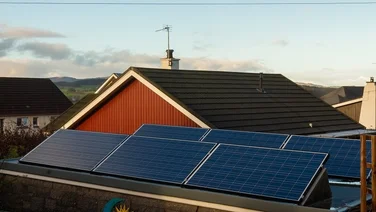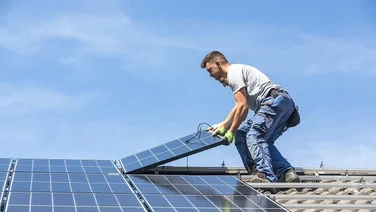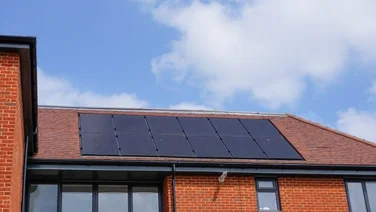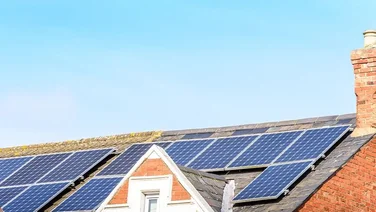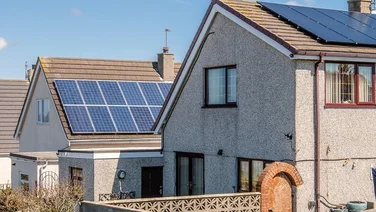- Solar farms generate solar energy on a massive scale
- The biggest solar farm in the UK is the 75MW Llanwern Solar Farm in Wales
- There are over 1,300 solar farms operating in the UK

Solar power is booming and taking up a greater share of the UK’s renewable energy generation each year. That means solar farms are increasingly essential to our growing demand for electricity and the UK’s goal to become a clean energy superpower.
Today, we’re looking at the biggest solar farms in the UK and why they have the potential for rapid expansion over the next few years. For clarity, we have ranked these solar farms by megawatt (MW) output, not by physical size or anything else.
If you’re more interested in getting your own solar system, we can help. Simply fill in our online form with a few details about your home.
The biggest solar farms in the UK
The largest solar farms in the UK are:
- Llanwern – 75MW (1st)
- Shotwick – 72.2MW (2nd)
- Owl’s Hatch – 49.99MW (3rd)
- West Raynham – 49.9MW, The Grange – 49.9MW, Larks Green – 49.9MW (joint 4th)
- Snarlton Farm – 49.6MW (5th)
- Eveley Farm – 49MW (6th)
Three of the solar farms on this list have the same MW capacity, and you might’ve noticed all but two on this list don’t go over 50MW. We’ve explained why further down.
These installations represent the current peak of solar farms in the UK, but there are several, much larger solar farms planned for the future and we imagine this top seven will look pretty different in the years to come.
In fact, there are around 150 currently under construction, with nearly 2,000 about to begin construction, and almost 700 solar farms awaiting approval.
What is a solar farm and how does one work?
Before we go into detail, we’ll quickly explain what a solar farm actually is. A solar farm is simply a large-scale installation of solar panels capable of generating a lot more power than your average rooftop solar system.
The solar panels used in solar farms tend to be bigger and more powerful than ones found on rooftops, with some panels going up to 700 watts (W). A typical solar panel used in a residential installation will be between 250W and 450W.
Solar farms work by capturing sunlight and converting it into direct current (DC) electricity. It is then converted by an inverter into alternating current (AC), which is then fed into the grid.
It’s exactly the same as a normal solar panel system, just much larger.
Larks Green Solar Farm which is on our list, became the first of its kind to connect directly to the National Grid.
Prior to this, solar farms in the UK have channeled their electricity through regional District Network Operators (DNO). These DNO are basically organisations that operate hardware supplying parts of the country with electricity on a local level.
Functionally, the main difference between DNO electricity and the electricity from the National Grid, is that the grid is responsible for transporting electricity across long distances, and DNO electricity is distributed locally.
Eveley Farm

Located in Hampshire, Eveley Farm hosts 186,000 solar panels provided by JinkoSolar, a Chinese solar panel manufacturer from Shanghai.
These panels combined have a power output of 49MW, which is enough to provide power to 12,300 homes, or enough to boil 25,500 kettles simultaneously.
One of the most interesting parts of Eveley Farm is how the installation of solar panels has actually made the area more biodiverse. It’s a common myth with solar farms that their presence is somehow bad for wildlife, but Everly Farm has proven otherwise.
The site has experienced increased soil fertility, reduced soil erosion, and a boost to biodiversity as both herbicides and pesticides are no longer used on the surrounding plants. Pollinators and other key species have had real opportunities to flourish around the solar farm.
| Developer | Location | Operating since | Area (km) | Power (MW) |
|---|---|---|---|---|
| Primrose Solar | Hampshire | 2016 | 0.7 | 49 |
Snarlton Farm
Situated to the east of Bath, this solar farm pips Everly Farm on this list with its 49.6MW capacity and ability to reduce carbon emissions by 10,500 tonnes each year.
Considering that the average carbon footprint for a person in the UK is between 5 and 12.7 tonnes of CO2e per year, Snarlton Farm is already making a big dent.
It’s spread out over roughly 200 acres and allows for grazing room for sheep – they can enjoy chewing on the grass while taking shelter from the sun underneath the panels.
Snarlton Farm utilises solar panels from S-Energy, a Korean company producing panels as powerful as 665W.
The solar farm has operated since 2016 and survived an initial planning permission rejection from the Wiltshire County Council. Throughout its expected lifespan (25+ years), Snarlton Farm will remove close to 300,000 tonnes of CO2e from the atmosphere.
| Developer | Location | Operating since | Area (km) | Power (MW) |
|---|---|---|---|---|
| Goldbeck Solar | Wiltshire | 2016 | 0.81 | 49.6 |

Get free solar panel quotes
Answer a few quick questions, and our trusted installers will send you bespoke solar panel quotes – for free.
Larks Green Solar Farm
What makes Larks Green Solar Farm an exciting prospect then, is that it represents the start of solar farms being able to send clean electricity to locations across the whole of the UK. Areas that would otherwise not be able to benefit from solar farms can now potentially do so.
Larks Green Solar Farm has 152,400 solar panels with a capacity of 49.9MW. Additionally, the solar farm has a colossal 99 megawatt hour (MWh) battery storage system, which its hundreds of thousands of solar panels can charge for use when solar energy isn’t available.
This storage also allows Larks Green Solar Farm to sell excess electricity back to the grid via the Smart Export Guarantee (SEG).
| Developer | Location | Operating since | Area (km) | Power (MW) |
|---|---|---|---|---|
| Enos Energy and Cero Generation | Gloucestershire | 2023 | 1.06 | 49.9 |
The Grange
The Grange solar farm in Gloucestershire has been providing close to 13,500 homes with clean, solar-generated electricity since 2021, all thanks to its impressive 49.9MW capacity.
It’s been providing a home for nature since then too, with biodiversity seeing a boost of 82% more habitat for wildlife, and an increase in hedgerows by 10%. Hedgerows are particularly important to birds in the spring, who use them for nest-building and when seeking refuge from predators.
And it’s been pretty great for the atmosphere, with the solar farm removing nearly 17,000 tonnes of carbon emissions each year, or roughly the equivalent of taking 3,600 cars off the road annually.
The Grange was developed by Lightsource BP, the largest solar developer in Europe and the third largest in the world outside of China. As you might guess from the name, Lightsource BP is owned by oil and gas company BP.
While it’s encouraging to see BP commit more to renewable energy infrastructure, the multinational company has a long way to go to offset its staggering annual emissions of 322 million tonnes of CO2e.
| Developer | Location | Operating since | Area (km) | Power (MW) |
|---|---|---|---|---|
| Lightsource BP | Nottinghamshire | 2021 | 0.84 | 49.9 |
West Raynham Airfield
The solar farm at West Raynham Airfield was built by Good Energy, one of the genuine good guys in the energy supplier world. Good Energy not only develops its own renewable energy sites, but it has committed to paying smaller renewable energy generators a fair price for the electricity they provide.
40% of the energy suppliers used by Good Energy don’t receive any government subsidies. This is important, because Good Energy is supporting energy suppliers that would likely not exist without support from the UK government.
In a sense, Good Energy’s support encourages the growth of smaller energy generators across the country.
The supplier’s solar farm has a capacity of 49.9MW, provided by roughly 200,000 solar panels, and can power close to 13,500 UK households.
| Developer | Location | Operating since | Area (km) | Power (MW) |
|---|---|---|---|---|
| Good Energy | Norfolk | 2015 | 0.91 | 49.9 |

Get free solar panel quotes
Answer a few quick questions, and our trusted installers will send you bespoke solar panel quotes – for free.
Owl’s Hatch Solar Park
This solar farm in Canterbury only just broke free from the 49.9MWs of the three farms above by adding 0.9MW to its total capacity. The margins are that fine here.
Owl’s Hatch Solar Park was developed by British Solar Renewables and has supplied clean electricity to nearly 13,000 nearby households since 2015. It’s doing a stellar job for the environment too, by removing just over 11,000 tonnes of CO2e from the atmosphere.
Contrary to what some people believe about solar farms, animals can actually continue to graze around the installed solar panels, and sheep do exactly that in and around Owl’s Hatch Solar Park.
| Developer | Location | Operating since | Area (km) | Power (MW) |
|---|---|---|---|---|
| British Solar Renewables | Canterbury | 2015 | 0.86 | 49.99 |
Shotwick Solar Farm
For a time, Shotwick Solar Farm in Wales sat at the top of the UK’s biggest solar farms with little fear of being caught – it has a massive capacity of 72.2MW and can provide clean electricity to roughly 18,000 UK households.
Some of this power goes towards the nearby UPM paper manufacturing plant, which manufactures 100% recycled paper.
As for its impact on the environment, Shotwick removes almost 16,000 tonnes of CO2e from the atmosphere each year.
The solar panels used came from Jetion Solar, a manufacturer in China, and are rated at just 225W – lower than you’d expect for a solar installation of this size.
| Developer | Location | Operating since | Area (km) | Power (MW) |
|---|---|---|---|---|
| British Solar Renewables, Compton Group and WElink Energy UK | Flintshire, Wales | 2016 | 0.89 | 72.2 |
Llanwern Solar Farm
The UK’s biggest solar farm is the Llanwern Solar Farm in south-east Wales, with a capacity of 75MW. It can provide power to nearly 20,000 UK homes, removing approximately 18,000 tonnes of CO2e each year.
Like many of the other solar farms on this list, Llanwern has actually been a net positive for biodiversity. The hedgerows near the site were initially trimmed to encourage greater growth, and to allow more sunlight to reach the nearby lake, which has resulted in more plant growth and wildlife diversity.
Additionally, the better management of the hedges has caused them to grow back thicker, making them more suitable for nesting birds. Llawnern’s developer, NextEnergy Capital, has created a 40-year environmental plan to ensure that the solar farm will play a key part in helping rare birds, small mammals, and invertebrates better flourish.
It’s examples like Llanwern that put to rest notions that solar farms are somehow bad for the environment. Especially when the development of solar farms goes hand in hand with a conscious effort to improve the habitats they’re being built in.
| Developer | Location | Operating since | Area (km) | Power (MW) |
|---|---|---|---|---|
| NextEnergy Capital | Gwent, Wales | 2021 | 1.05 | 75 |
Why do so many solar farms not go above 49.9MW?
You may be wondering why a lot of the solar farms on this list don’t go above 49.9MW. The reason is (or was) red tape – UK planning laws specify that solar sites with a capacity greater than 50MW are considered a “Nationally Significant Infrastructure Project”, which can only be approved by the Department of Energy Security and Net Zero’s Secretary of State.
That’s quite the hurdle then. Or at least it was, until the UK government clarified in 2021 that actually the 50MW limit referred to a solar farm’s actual output, instead of its peak power output.
Now that this has been cleared up, we’ll no doubt be seeing many more solar farms with larger capacities over the next few years.
Summary
Solar power is growing in the UK and with it, solar farms.
It is highly likely that within a few years, this list of the biggest solar farms in the UK will already be outdated, as more and more large-scale solar projects are being approved all the time.
For example, there’s already been approval for the development of a massive 373MW solar farm in Kent. And, in September 2024, the UK government gave the go-ahead for the 600MW Cottam Solar Project, which will provide power to thousands of UK homes and cut carbon emissions substantially.



